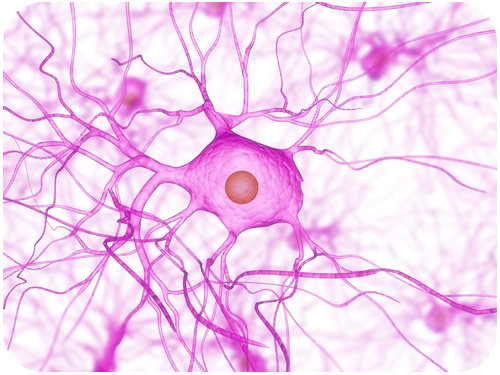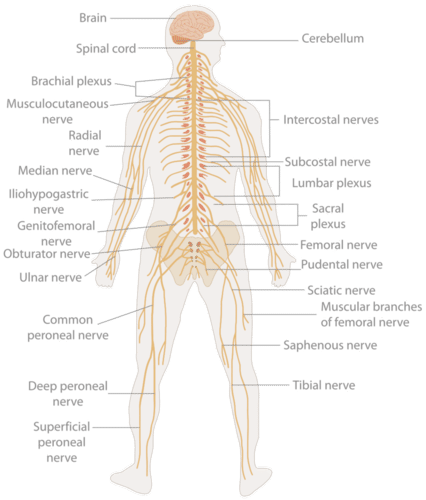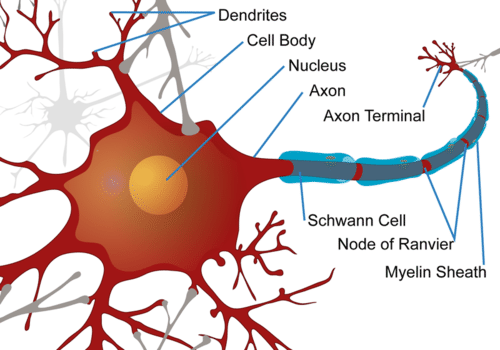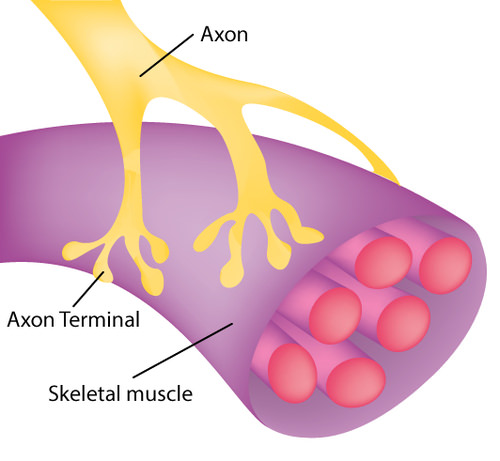13.4: Neuron
- Page ID
- 13275
\( \newcommand{\vecs}[1]{\overset { \scriptstyle \rightharpoonup} {\mathbf{#1}} } \)
\( \newcommand{\vecd}[1]{\overset{-\!-\!\rightharpoonup}{\vphantom{a}\smash {#1}}} \)
\( \newcommand{\dsum}{\displaystyle\sum\limits} \)
\( \newcommand{\dint}{\displaystyle\int\limits} \)
\( \newcommand{\dlim}{\displaystyle\lim\limits} \)
\( \newcommand{\id}{\mathrm{id}}\) \( \newcommand{\Span}{\mathrm{span}}\)
( \newcommand{\kernel}{\mathrm{null}\,}\) \( \newcommand{\range}{\mathrm{range}\,}\)
\( \newcommand{\RealPart}{\mathrm{Re}}\) \( \newcommand{\ImaginaryPart}{\mathrm{Im}}\)
\( \newcommand{\Argument}{\mathrm{Arg}}\) \( \newcommand{\norm}[1]{\| #1 \|}\)
\( \newcommand{\inner}[2]{\langle #1, #2 \rangle}\)
\( \newcommand{\Span}{\mathrm{span}}\)
\( \newcommand{\id}{\mathrm{id}}\)
\( \newcommand{\Span}{\mathrm{span}}\)
\( \newcommand{\kernel}{\mathrm{null}\,}\)
\( \newcommand{\range}{\mathrm{range}\,}\)
\( \newcommand{\RealPart}{\mathrm{Re}}\)
\( \newcommand{\ImaginaryPart}{\mathrm{Im}}\)
\( \newcommand{\Argument}{\mathrm{Arg}}\)
\( \newcommand{\norm}[1]{\| #1 \|}\)
\( \newcommand{\inner}[2]{\langle #1, #2 \rangle}\)
\( \newcommand{\Span}{\mathrm{span}}\) \( \newcommand{\AA}{\unicode[.8,0]{x212B}}\)
\( \newcommand{\vectorA}[1]{\vec{#1}} % arrow\)
\( \newcommand{\vectorAt}[1]{\vec{\text{#1}}} % arrow\)
\( \newcommand{\vectorB}[1]{\overset { \scriptstyle \rightharpoonup} {\mathbf{#1}} } \)
\( \newcommand{\vectorC}[1]{\textbf{#1}} \)
\( \newcommand{\vectorD}[1]{\overrightarrow{#1}} \)
\( \newcommand{\vectorDt}[1]{\overrightarrow{\text{#1}}} \)
\( \newcommand{\vectE}[1]{\overset{-\!-\!\rightharpoonup}{\vphantom{a}\smash{\mathbf {#1}}}} \)
\( \newcommand{\vecs}[1]{\overset { \scriptstyle \rightharpoonup} {\mathbf{#1}} } \)
\( \newcommand{\vecd}[1]{\overset{-\!-\!\rightharpoonup}{\vphantom{a}\smash {#1}}} \)
\(\newcommand{\avec}{\mathbf a}\) \(\newcommand{\bvec}{\mathbf b}\) \(\newcommand{\cvec}{\mathbf c}\) \(\newcommand{\dvec}{\mathbf d}\) \(\newcommand{\dtil}{\widetilde{\mathbf d}}\) \(\newcommand{\evec}{\mathbf e}\) \(\newcommand{\fvec}{\mathbf f}\) \(\newcommand{\nvec}{\mathbf n}\) \(\newcommand{\pvec}{\mathbf p}\) \(\newcommand{\qvec}{\mathbf q}\) \(\newcommand{\svec}{\mathbf s}\) \(\newcommand{\tvec}{\mathbf t}\) \(\newcommand{\uvec}{\mathbf u}\) \(\newcommand{\vvec}{\mathbf v}\) \(\newcommand{\wvec}{\mathbf w}\) \(\newcommand{\xvec}{\mathbf x}\) \(\newcommand{\yvec}{\mathbf y}\) \(\newcommand{\zvec}{\mathbf z}\) \(\newcommand{\rvec}{\mathbf r}\) \(\newcommand{\mvec}{\mathbf m}\) \(\newcommand{\zerovec}{\mathbf 0}\) \(\newcommand{\onevec}{\mathbf 1}\) \(\newcommand{\real}{\mathbb R}\) \(\newcommand{\twovec}[2]{\left[\begin{array}{r}#1 \\ #2 \end{array}\right]}\) \(\newcommand{\ctwovec}[2]{\left[\begin{array}{c}#1 \\ #2 \end{array}\right]}\) \(\newcommand{\threevec}[3]{\left[\begin{array}{r}#1 \\ #2 \\ #3 \end{array}\right]}\) \(\newcommand{\cthreevec}[3]{\left[\begin{array}{c}#1 \\ #2 \\ #3 \end{array}\right]}\) \(\newcommand{\fourvec}[4]{\left[\begin{array}{r}#1 \\ #2 \\ #3 \\ #4 \end{array}\right]}\) \(\newcommand{\cfourvec}[4]{\left[\begin{array}{c}#1 \\ #2 \\ #3 \\ #4 \end{array}\right]}\) \(\newcommand{\fivevec}[5]{\left[\begin{array}{r}#1 \\ #2 \\ #3 \\ #4 \\ #5 \\ \end{array}\right]}\) \(\newcommand{\cfivevec}[5]{\left[\begin{array}{c}#1 \\ #2 \\ #3 \\ #4 \\ #5 \\ \end{array}\right]}\) \(\newcommand{\mattwo}[4]{\left[\begin{array}{rr}#1 \amp #2 \\ #3 \amp #4 \\ \end{array}\right]}\) \(\newcommand{\laspan}[1]{\text{Span}\{#1\}}\) \(\newcommand{\bcal}{\cal B}\) \(\newcommand{\ccal}{\cal C}\) \(\newcommand{\scal}{\cal S}\) \(\newcommand{\wcal}{\cal W}\) \(\newcommand{\ecal}{\cal E}\) \(\newcommand{\coords}[2]{\left\{#1\right\}_{#2}}\) \(\newcommand{\gray}[1]{\color{gray}{#1}}\) \(\newcommand{\lgray}[1]{\color{lightgray}{#1}}\) \(\newcommand{\rank}{\operatorname{rank}}\) \(\newcommand{\row}{\text{Row}}\) \(\newcommand{\col}{\text{Col}}\) \(\renewcommand{\row}{\text{Row}}\) \(\newcommand{\nul}{\text{Nul}}\) \(\newcommand{\var}{\text{Var}}\) \(\newcommand{\corr}{\text{corr}}\) \(\newcommand{\len}[1]{\left|#1\right|}\) \(\newcommand{\bbar}{\overline{\bvec}}\) \(\newcommand{\bhat}{\widehat{\bvec}}\) \(\newcommand{\bperp}{\bvec^\perp}\) \(\newcommand{\xhat}{\widehat{\xvec}}\) \(\newcommand{\vhat}{\widehat{\vvec}}\) \(\newcommand{\uhat}{\widehat{\uvec}}\) \(\newcommand{\what}{\widehat{\wvec}}\) \(\newcommand{\Sighat}{\widehat{\Sigma}}\) \(\newcommand{\lt}{<}\) \(\newcommand{\gt}{>}\) \(\newcommand{\amp}{&}\) \(\definecolor{fillinmathshade}{gray}{0.9}\)
A close-up view of a spider web? Some sort of exotic bacteria? What do you think this is?
This is actually a nerve cell, the cell of the nervous system. This cell sends electrical “sparks” that transmit signals throughout your body.
The Nervous System
A small child darts in front of your bike as you race down the street. You see the child and immediately react. You put on the brakes, steer away from the child, and yell out a warning, all in just a split second. How do you respond so quickly? Such rapid responses are controlled by your nervous system. The nervous system is a complex network of nervous tissue that carries electrical messages throughout the body. It includes the brain and spinal cord, the central nervous system, and nerves that run throughout the body, the peripheral nervous system (see Figure below). To understand how nervous messages can travel so quickly, you need to know more about nerve cells.
 The human nervous system includes the brain and spinal cord (central nervous system) and nerves that run throughout the body (peripheral nervous system).
The human nervous system includes the brain and spinal cord (central nervous system) and nerves that run throughout the body (peripheral nervous system).Nerve Cells
Although the nervous system is very complex, nervous tissue consists of just two basic types of nerve cells: neurons and glial cells. Neurons are the structural and functional units of the nervous system. They transmit electrical signals, called nerve impulses. Glial cells provide support for neurons. For example, they provide neurons with nutrients and other materials.
Neuron Structure
As shown in Figure below, a neuron consists of three basic parts: the cell body, dendrites, and axon.
- The cell body contains the nucleus and other cell organelles.
- Dendrites extend from the cell body and receive nerve impulses from other neurons.
- The axon is a long extension of the cell body that transmits nerve impulses to other cells. The axon branches at the end, forming axon terminals. These are the points where the neuron communicates with other cells.
 The structure of a neuron allows it to rapidly transmit nerve impulses to other cells.
The structure of a neuron allows it to rapidly transmit nerve impulses to other cells.The axon of many neurons has an outer layer called a myelin sheath (see Figure above). Myelin is a lipid produced by a type of a glial cell known as a Schwann cell. The myelin sheath acts like a layer of insulation, similar to the plastic that encases an electrical cord. Regularly spaced nodes, or gaps, in the myelin sheath allow nerve impulses to skip along the axon very rapidly.
Types of Neurons
Neurons are classified based on the direction in which they carry nerve impulses.
- Sensory neurons carry nerve impulses from tissues and organs to the spinal cord and brain.
- Motor neurons carry nerve impulses from the brain and spinal cord to muscles and glands (see Figure below).
- Interneurons carry nerve impulses back and forth between sensory and motor neurons.
 This axon is part of a motor neuron. It transmits nerve impulses to a skeletal muscle, causing the muscle to contract.
This axon is part of a motor neuron. It transmits nerve impulses to a skeletal muscle, causing the muscle to contract.Summary
- Neurons are the structural and functional units of the nervous system. They consist of a cell body, dendrites, and axon.
- Neurons transmit nerve impulses to other cells.
- Types of neurons include sensory neurons, motor neurons, and interneurons.
Review
- What are the two main parts of the nervous system?
- List and describe the parts of a neuron.
- What do motor neurons do?
- What is myelin and the myelin sheath?
| Image | Reference | Attributions |
 |
[Figure 1] | Credit: Zachary Wilson Source: CK-12 Foundation License: CC BY-NC 3.0 |
 |
[Figure 2] | Credit: User:The Emirr/Wikimedia Commons Source: commons.wikimedia.org/wiki/File:TE-Nervous_system_diagram.svg License: CC BY 3.0 |
 |
[Figure 3] | Credit: Zachary Wilson/CK-12 Foundation, based on image by Mariana Ruiz Villarreal (User:LadyofHats/Wikimedia Commons) Source: Original: commons.wikimedia.org/wiki/File:Complete_neuron_cell_diagram_en.svg License: CC BY-NC 3.0 |
 |
[Figure 4] | Credit: Zachary Wilson Source: CK-12 Foundation License: CC BY-NC 3.0 |

